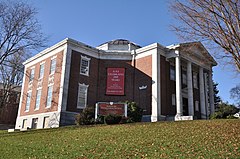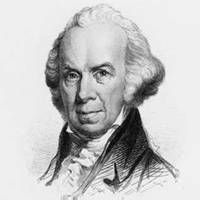American Antiquarian Society
 | |
 | |
| Country | United States |
|---|---|
| Type | Private |
| Established | 1812 |
| Architect | Winslow, Bigelow & Wadsworth |
| Location | 185 Salisbury Street, Worcester, Massachusetts |
| Coordinates | 42°16′38″N 71°48′39″W / 42.27722°N 71.81083°WCoordinates: 42°16′38″N 71°48′39″W / 42.27722°N 71.81083°W |
| Branches | 1 |
| Access and use | |
| Population served | 1,052 (Membership, 2016) |
| Other information | |
| Director | Scott E. Casper |
| Staff | 45 |
| Website | americanantiquarian.org |
| Map | |
 | |
American Antiquarian Society | |
U.S. National Register of Historic Places | |
 | |
| Area | 1.8 acres (7,300 m2) |
| Built | 1910 |
| Architectural style | Colonial Revival |
| NRHP reference No. | 68000018 |
| Significant dates | |
| Added to NRHP | November 24, 1968[1] |
| Designated NHL | November 24, 1968[2] |
The American Antiquarian Society (AAS), located in Worcester, Massachusetts, is both a learned society and national research library of pre-twentieth century American history and culture. Founded in 1812, it is the oldest historical society in the United States with a national focus.[3] Its main building, known as Antiquarian Hall, is a U.S. National Historic Landmark in recognition of this legacy.[4] The mission of the AAS is to collect, preserve and make available for study all printed records of what is now known as the United States of America. This includes materials from the first European settlement through the year 1876.[5]
The AAS offers programs for professional scholars, pre-collegiate, undergraduate and graduate students, educators, professional artists, writers, genealogists, and the general public.[6] AAS has many digital collections available, including "A New Nation Votes: American Election Returns 1788–1824."[7]
The collections of the AAS contain over three million books, pamphlets, newspapers, periodicals, graphic arts materials and manuscripts. The Society is estimated to hold copies of two-thirds of the total books known to have been printed in what is now the United States from the establishment of the first press in 1640 through the year 1820; many of these volumes are exceedingly rare and a number of them are unique.[8] Historic materials from all fifty U.S. states, most of Canada and the British West Indies are included in the AAS repository. One of the more famous volumes held by the Society is a copy of the first book printed in America, the Bay Psalm Book.[9] AAS also has one of the largest collections of newspapers printed in America through 1876, with more than two million issues in its collection.[10]
History[]

On the initiative of Isaiah Thomas, the AAS was founded on October 24, 1812, through an act of the Massachusetts General Court.[11] It was the third historical society established in America, and the first to be national in its scope.[4] Isaiah Thomas started the collection with approximately 8,000 books from his personal library.[12] The first library building was erected in 1820 in downtown Worcester, Massachusetts.[13] In 1853, the Society moved its collections to a larger building at the corner of Highland Street, also in Worcester.[14] This building was later abandoned and another new building was constructed. Designed by Winslow, Bigelow & Wadsworth, the Georgian Revival building was completed in 1910 and stands on the corner of Park Avenue and Salisbury Street. There have been several additions to this building to accommodate the growing collection, the most recent of which was completed in 2003.[15] AAS was presented with the 2013 National Humanities Medal by President Obama in a ceremony at the White House.[16]
History of printing[]
As part of AAS's mission as a learned society, it offers a variety of public lectures and seminars. One topic to which AAS dedicates significant academic energies is printing technology, especially in eighteenth-century British North America. Since Isaiah Thomas was a newspaper man himself, he collected a large number of printed materials.[17] With regard to printing, paper making, edition setting, and reprinting, not much had changed in European technology by the eighteenth century. It was not until the late eighteenth century that paper-making material began to evolve from a hand-woven cloth to an industrial pulp. AAS undertakes special efforts to preserve printed records from this time period, as the Society maintains an on-site conservation department with various sewing, cloth, and binding materials to aid in the preservation process.[18]
Notable members[]
The American Antiquarian Society's membership includes scholars, writers, journalists, filmmakers, collectors, American presidents, and civic leaders.[19] Notable members include the following individuals:
- Benjamin Abbot
- John Adams
- John Quincy Adams
- Herman Vandenburg Ames
- Roald Amundsen
- Ken Burns
- Jimmy Carter
- Bill Clinton
- Calvin Coolidge
- Walter Cronkite
- Moses Fisk
- Esther Forbes
- Henry Louis Gates
- Samuel Swett Green
- Annette Gordon-Reed
- Rutherford B. Hayes
- Washington Irving
- Andrew Jackson
- John Jay
- Thomas Jefferson
- Tobias Lear
- Jill Lepore
- James Madison
- Othniel Charles Marsh
- Louis Masur
- David McCullough
- James Monroe
- Nathaniel Philbrick
- Dorothy B. Porter
- John Wesley Powell
- Franklin Pierce Rice
- Franklin D. Roosevelt
- Theodore Roosevelt
- George Dudley Seymour
- William H. Taft
- Bushrod Washington
- Woodrow Wilson
See also[]
- Books in the United States
- History of books
- List of antiquarian societies
- Massachusetts Historical Society
- John Ratcliff
- List of National Historic Landmarks in Massachusetts
- National Register of Historic Places listings in northwestern Worcester, Massachusetts
References[]
- ^ "National Register Information System". National Register of Historic Places. National Park Service. January 23, 2007.
- ^ "American Antiquarian Society". National Historic Landmark summary listing. National Park Service. Retrieved July 10, 2008.
- ^ Gura, Philip F. The American Antiquarian Society, 1812–2012: A Bicentennial History (Worcester: American Antiquarian Society, 2012) p. x
- ^ Jump up to: a b http://tps.cr.nps.gov/nhl/detail.cfm?ResourceId=775&ResourceType=Building
- ^ aasmaster (March 28, 2017). "Mission Statement". Retrieved December 22, 2017.
- ^ aaswebsite (August 25, 2012). "Programs & Events". Retrieved December 22, 2017.
- ^ aaswebsite (August 25, 2012). "Digital AAS". Retrieved December 22, 2017.
- ^ aasmaster (October 2, 2012). "Tours". Retrieved December 22, 2017.
- ^ Gura, p. 24
- ^ aasmaster (October 22, 2012). "Newspapers". Retrieved December 22, 2017.
- ^ Gura, p. 1
- ^ Gura, p. 33
- ^ Gura, p. 32
- ^ Gura, pp. 98-99
- ^ "Development Department of the American Antiquarian Society". www.americanantiquarian.org. Retrieved December 22, 2017.
- ^ "President Obama Awards 2013 National Humanities Medals". National Endowment for the Humanities. Retrieved December 22, 2017.
- ^ Gura, pp. 14, 33
- ^ "Archived copy". Archived from the original on November 16, 2010. Retrieved June 13, 2011.CS1 maint: archived copy as title (link)
- ^ aasmaster (February 28, 2018). "Members Directory". Retrieved February 28, 2018.
Further reading[]
- Goslow, Brian (January 30, 2014). "Worcester's best kept secret: The American Antiquarian Society belongs to everyone". Worcester Magazine. Archived from the original on October 17, 2014. Retrieved October 10, 2014.
- Gura, Philip F. The American Antiquarian Society, 1812–2012: A Bicentennial History (Worcester: American Antiquarian Society, 2012) 454 pp.
- Shipton, Clifford K. "The American Antiquarian Society." William and Mary Quarterly (1945): 164-172.
- Vail, R. W. G. "The American Antiquarian Society." Business History Review 7.6 (1933): 1-5.
External links[]
- Proceedings of the American Antiquarian Society. Worcester, Mass.: the Society, 1843–
External links[]
- Historical societies of the United States
- National Historic Landmarks in Massachusetts
- Historical societies in Massachusetts
- Member organizations of the American Council of Learned Societies
- Learned societies of the United States
- Organizations based in Worcester, Massachusetts
- Buildings and structures in Worcester, Massachusetts
- Libraries on the National Register of Historic Places in Massachusetts
- 1812 establishments in Massachusetts
- Libraries in Worcester, Massachusetts
- Library buildings completed in 1820
- Library buildings completed in 1910
- National Register of Historic Places in Worcester, Massachusetts
- National Humanities Medal recipients
- Special collections libraries
- Museums in Worcester, Massachusetts




